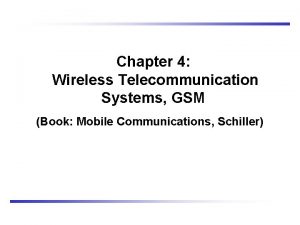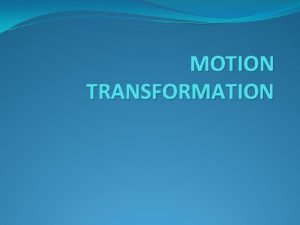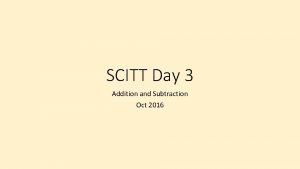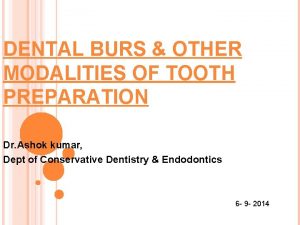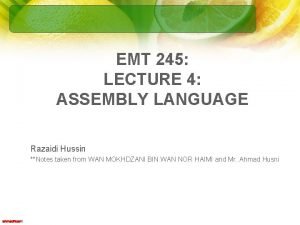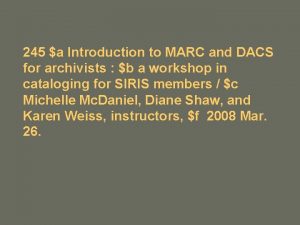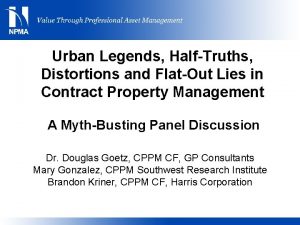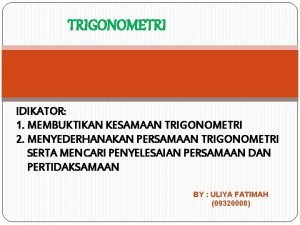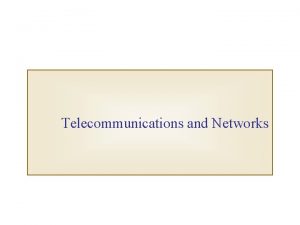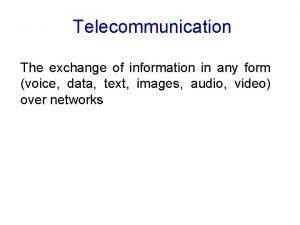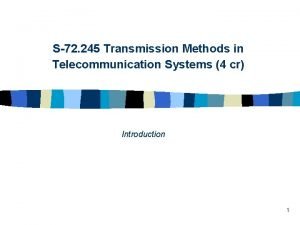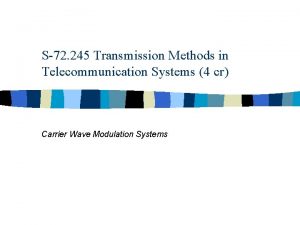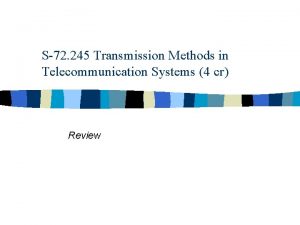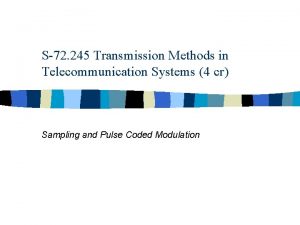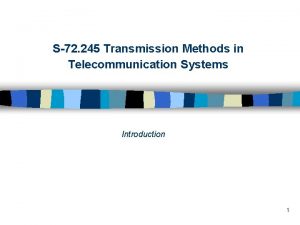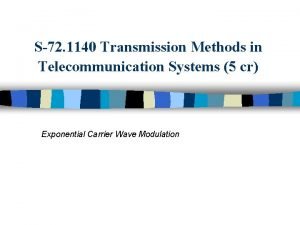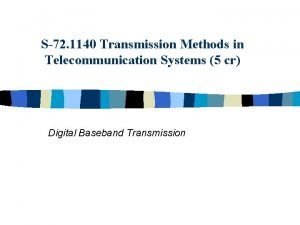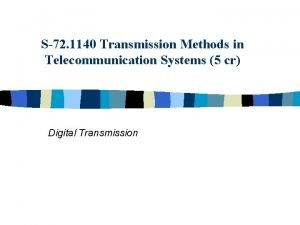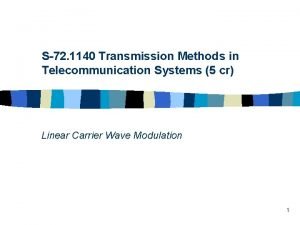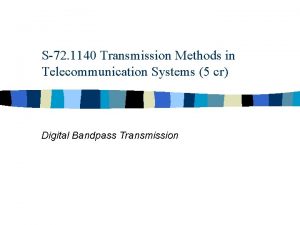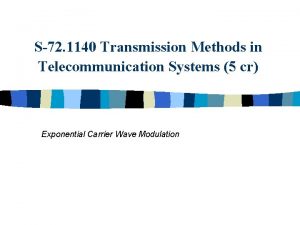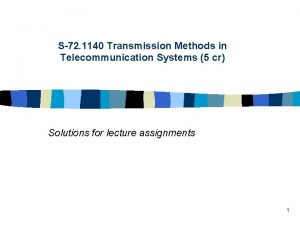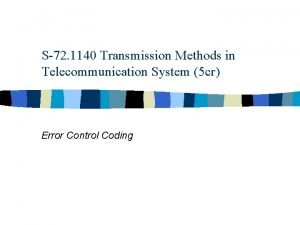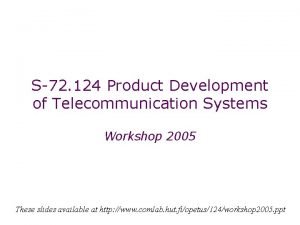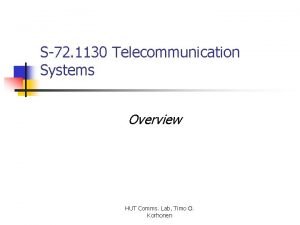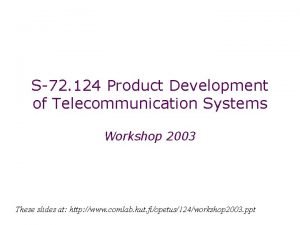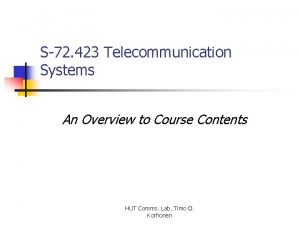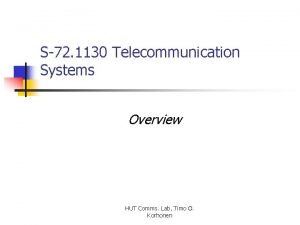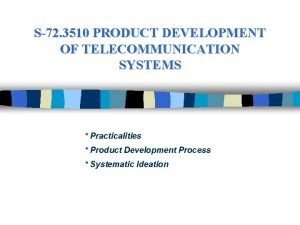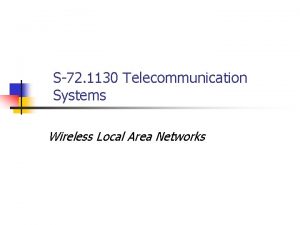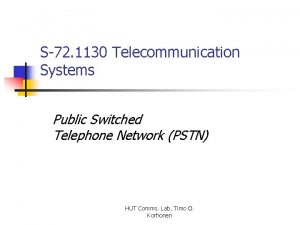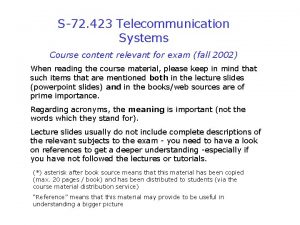S72 245 Transmission Methods in Telecommunication Systems 4

























- Slides: 25

S-72. 245 Transmission Methods in Telecommunication Systems (4 cr) Linear Carrier Wave Modulation 1

Linear carrier wave (CW) modulation n n n Bandpass systems and signals Lowpass (LP) equivalents Amplitude modulation (AM) Double-sideband modulation (DSB) Modulator techniques Suppressed-sideband amplitude modulation (LSB, USB) Detection techniques of linear modulation – Coherent detection – Noncoherent detection AM DSB LSB USB 2 Helsinki University of Technology, Communications Laboratory, Timo O. Korhonen

Baseband CW communications carrier n n Baseband communications is used in – PSTN local loop baseband CW – PCM communications for instance between exchanges – (fiber-) optical communication Using carrier to shape and shift the frequency spectrum (eg CW techniques) enable modulation by which several advantages are obtained – different radio bands can be used for communications – wireless communications – multiplexing techniques become applicable – exchanging transmission bandwidth to received SNR 3 Helsinki University of Technology, Communications Laboratory, Timo O. Korhonen

Defining bandpass signals n The bandpass signal is band limited n We assume also that (why? ) n In telecommunications bandpass signals are used to convey messages over medium In practice, transmitted messages are never strictly band limited due to – their nature in frequency domain (Fourier series coefficients may extend over very large span of frequencies) 4 – non-ideal filtering n Helsinki University of Technology, Communications Laboratory, Timo O. Korhonen

Example of a bandpass system n Consider a simple bandpass system: a resonant (tank) circuit Tank circuit 5 Helsinki University of Technology, Communications Laboratory, Timo O. Korhonen

Bandwidth and Q-factor n The bandwidth is inversely proportional to Q-factor: n System design is easier (next slide) if the fractional bandwidth 1/Q=B/f 0 is kept relatively small: n Some practical examples: 6 Helsinki University of Technology, Communications Laboratory, Timo O. Korhonen

Why system design is easier for smaller fractional bandwidths (FB)? n n Antenna and bandpass amplifier design is difficult for large FB: s: – one will have “difficult to realize” components or parameters in circuits as • too high Q • too small or large values for capacitors and inductors These structures have a bandpass nature because one of their important elements is the resonant circuit. Making them broadband means decreasing resistive losses that can be difficult 7 Helsinki University of Technology, Communications Laboratory, Timo O. Korhonen

I-Q (in-phase-quadrature) description for bandpass signals n In I-Q presentation bandpass signal carrier and modulation parts are separated into different terms Bandpass signal in frequency domain Bandpass signal in time domain Helsinki University of Technology, Communications Laboratory, Timo O. Korhonen dashed line denotes envelope 8

The phasor description of bandpass signal n Bandpass signal is conveniently represented by a phasor rotating at the angular carrier rate : 9 Helsinki University of Technology, Communications Laboratory, Timo O. Korhonen

Lowpass (LP) signal n Lowpass signal is defined by yielding in time domain Taking rectangular-polar conversion yields then 10 Helsinki University of Technology, Communications Laboratory, Timo O. Korhonen

Transforming lowpass signals and bandpass signals n Physically this means that the lowpass signal is modulated to the carrier frequency w when it is transformed to bandpass signal. Bandpass signal can be transformed into lowpass signal by (tutorials). What is the physical meaning of this? 11 Helsinki University of Technology, Communications Laboratory, Timo O. Korhonen

Amplitude modulation (AM) n n n We discuss three linear mod. methods: (1) AM (amplitude modulation), (2) DSB (double sideband modulation), (3) SSB (single sideband modulation) AM signal: f(t) is an arbitrary constant. Hence we note that no information is transmitted via the phase. Assume for instance that f(t)=0, then the LP components are n Also, the carrier component contains no information-> Waste of power to transmit the unmodulated carrier, but can still be useful (how? ) 12 Helsinki University of Technology, Communications Laboratory, Timo O. Korhonen

AM: waveforms and bandwidth n AM in frequency domain: n AM bandwidth is twice the message bandwidth W: 13 Helsinki University of Technology, Communications Laboratory, Timo O. Korhonen

AM waveforms (a): modulation (b): modulated carrier with m<1 (c): modulated carrier with m>1 Envelope distortion! 14 Helsinki University of Technology, Communications Laboratory, Timo O. Korhonen

AM power efficiency n n AM wave total power consists of the idle carrier part and the useful signal part: Assume AC=1, SX=1, then for m=1 (the max value) the total power is Therefore at least half of the total power is wasted on carrier Detection of AM is simple by enveloped detector that is a reason why AM is still used. Also, sometimes AM makes system design easier, as in fiber optic communications Helsinki University of Technology, Communications Laboratory, Timo O. Korhonen 15

DSB signals and spectra n In DSB the wasteful carrier is suppressed: n The spectra is otherwise identical to AM and the transmission BW equals again double the message BW n In time domain each modulation signal zero crossing produces phase reversals of the carrier. For DSB, the total power ST and the power/sideband PSB have the relationship n Therefore AM transmitter requires twice the power of DSB transmitter to produce the same coverage assuming SX=1. However, in practice SX is usually smaller than 1/2, under which condition at least four times the DSB power is required for the AM transmitter for the same coverage 16 Helsinki University of Technology, Communications Laboratory, Timo O. Korhonen

DSB and AM spectra n AM in frequency domain with n In summary, difference of AM and DSB at frequency domain is the missing carrier component. Other differences relate to power efficiency and detection techniques. (a) DSB spectra, (b) AM spectra 17 Helsinki University of Technology, Communications Laboratory, Timo O. Korhonen

AM phasor analysis, tone modulation n AM and DSB can be inspected also by trigonometric expansion yielding for instance for AM n This has a nice phasor interpretation; take for instance m=2/3, Am=1: 18 Helsinki University of Technology, Communications Laboratory, Timo O. Korhonen

Linear modulators n n n Note that AM and DSB systems generate new frequency components that were not present at the carrier or at the message. Hence modulator must be a nonlinear system Both AM and DSB can be generated by – analog or digital multipliers – special nonlinear circuits • based on semiconductor junctions (as diodes, FETs etc. ) • based on analog or digital nonlinear amplifiers as – log-antilog amplifiers: Log 19 Helsinki University of Technology, Communications Laboratory, Timo O. Korhonen

n (a) Product modulator (b) respective schematic diagram =multiplier+adder 20 Helsinki University of Technology, Communications Laboratory, Timo O. Korhonen

Square-law modulator (for AM) n Square-law modulators are based on nonlinear elements: (a) functional block diagram, (b) circuit realization Helsinki University of Technology, Communications Laboratory, Timo O. Korhonen 21

Balanced modulator (for DSB) n By using balanced configuration non-idealities on square-law characteristics can be compensated resulting a high degree of carrier suppression: n Note that if the modulating signal has a DC-component, it is not cancelled out and will appear at the carrier frequency of the modulator output 22 Helsinki University of Technology, Communications Laboratory, Timo O. Korhonen

Synchronous detection n All linear modulations can be detected by synchronous detector Regenerated, in-phase carrier replica required for signal regeneration that is used to multiple the received signal Consider an universal*, linearly modulated signal: n The multiplied signal y(t) is: n n Synchronous detector *What are the parameters for example for AM or DSB? Helsinki University of Technology, Communications Laboratory, Timo O. Korhonen 23

The envelope detector n Important motivation for using AM is the possibility to use the envelope detector that – has a simple structure (also cheap) – needs no synchronization (e. g. no auxiliary, unmodulated carrier input in receiver) – no threshold effect ( SNR can be very small and receiver still works) 24 Helsinki University of Technology, Communications Laboratory, Timo O. Korhonen

Envelope detector analyzed n Assume diode half-wave rectifier used to rectify AM-signal. Therefore after the diode AM modulation is in effect multiplied with the half-wave rectified sinusoidal signal w(t) + other higher order terms n n n The diode detector is then followed by a lowpass circuit to remove the higher order terms The resulting DC-term may also be blocked by a capacitor Note the close resembles of this principle to the synchronousdetector (why? ) 25 Helsinki University of Technology, Communications Laboratory, Timo O. Korhonen
 Telecommunication systems book
Telecommunication systems book Motion transmission and transformation systems
Motion transmission and transformation systems Whats a gear train
Whats a gear train Motion transmission systems
Motion transmission systems Use a number line to solve 245-137
Use a number line to solve 245-137 245 angle
245 angle Prime factorization 120
Prime factorization 120 Burs used for crown preparation
Burs used for crown preparation Far 52-245-1
Far 52-245-1 Ge 245
Ge 245 Emt 245
Emt 245 700 e yuvarlanan en küçük sayı
700 e yuvarlanan en küçük sayı Marc 245
Marc 245 Far52.245-1
Far52.245-1 Meyb-245
Meyb-245 245 nömrəli tam orta məktəb
245 nömrəli tam orta məktəb Menyederhanakan trigonometri
Menyederhanakan trigonometri The frame acd is hinged at a and d
The frame acd is hinged at a and d Marc21 245
Marc21 245 Direct wax pattern
Direct wax pattern Project management telecommunications
Project management telecommunications Objectives of telecommunication
Objectives of telecommunication Types of telecommunication networks
Types of telecommunication networks Telecommunication meaning
Telecommunication meaning Introduction to telecommunication
Introduction to telecommunication Kyushu telecommunication network co.,inc.
Kyushu telecommunication network co.,inc.
